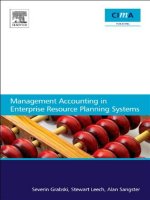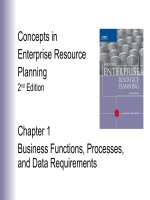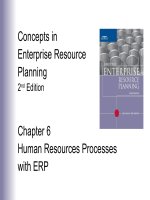Concepts in enterprise resource planning 4th accounting in ERP systems CH05
Bạn đang xem bản rút gọn của tài liệu. Xem và tải ngay bản đầy đủ của tài liệu tại đây (931.99 KB, 58 trang )
Concepts in Enterprise
Resource Planning
Fourth Edition
Chapter Five
Accounting in ERP Systems
Objectives
After completing this chapter, you will be able to:
• Describe the differences between financial and
managerial accounting
• Identify and describe problems associated with
accounting and financial reporting in unintegrated
information systems
• Describe how ERP systems can help solve
accounting and financial reporting problems in an
unintegrated system
Concepts in Enterprise Resource Planning, Fourth Edition
2
Objectives (cont’d.)
• Describe how the Enron scandal and the
Sarbanes-Oxley Act have affected accounting
information systems
• Explain accounting and management-reporting
benefits that accrue from having an ERP system
• Explain the importance of Extensible Business
Reporting Language (XBRL) in financial reporting
Concepts in Enterprise Resource Planning, Fourth Edition
3
Introduction
• In this chapter, you will learn about the activities in
the Accounting functional area
• Accounting is tightly integrated with all other
functional areas
• Accounting activities are necessary for decision
making
Concepts in Enterprise Resource Planning, Fourth Edition
4
Accounting Activities
• Areas of accounting:
– Financial accounting
– Managerial accounting
• Financial accounting
– Documenting all transactions of a company that
have an impact on the financial state of the firm
– Using documented transactions to create reports for
external parties and agencies
– Reports, or financial statements, must follow
prescribed rules and guidelines of various agencies
Concepts in Enterprise Resource Planning, Fourth Edition
5
Accounting Activities (cont’d.)
• Common financial statements: balance sheets and
income statements
• Balance sheet
– Statement that shows account balances such as:
•
•
•
•
•
•
Cash held
Amounts owed to company by customers
Cost of raw materials and finished-goods inventory
Long-term assets such as buildings
Amounts owed to vendors, banks, and other creditors
Amounts owners have invested in company
Concepts in Enterprise Resource Planning, Fourth Edition
6
Figure 5-1 Fitter Snacker sample balance sheet
Concepts in Enterprise Resource Planning, Fourth Edition
7
Accounting Activities (cont’d.)
• Income statement
– Profit and loss (P&L) statement
– Shows company’s sales, cost of sales, and profit or
loss for a period of time (typically a quarter or year)
• Integrated information system simplifies the
process of closing the books and preparing
financial statements
• Managerial accounting: determining costs and
profitability of company’s activities
Concepts in Enterprise Resource Planning, Fourth Edition
8
Figure 5-2 Fitter Snacker sample income statement
Concepts in Enterprise Resource Planning, Fourth Edition
9
Accounting Activities (cont’d.)
• Quarterly financial statement
–
–
–
–
–
Close books
Closing entries to nominal accounts
Nominal accounts – zero balance to start next cycle
Ensure accounts accurate and up-to-date
“Adjusting” entries
• Integrated information system advantage
– Simplifies process of closing books and preparing
financial statements
Concepts in Enterprise Resource Planning, Fourth Edition
10
Figure 5-3 Balance sheet and income statement for Fitter Snacker in SAP
ERP system
Concepts in Enterprise Resource Planning, Fourth Edition
11
Accounting Activities (cont’d.)
• Managerial accounting
– Determine costs and profitability of company’s
activities
– Provide managers with detailed information
• Informed decisions
• Create budgets
• Determine profitability
– Information that managers use to control day-to-day
activities, develop long-term plans
Concepts in Enterprise Resource Planning, Fourth Edition
12
Using ERP for Accounting Information
• Problems associated with unintegrated systems
– Data sharing usually did not occur in real time
• Accounting’s data were often out of date
– Accounting personnel had to do significant research
• ERP system, with its centralized database, avoids
these problems
• In traditional accounting, company’s accounts are
kept in a record called a general ledger
Concepts in Enterprise Resource Planning, Fourth Edition
13
Using ERP for Accounting Information
(cont’d.)
• In the SAP ERP system, input to general ledger
occurs simultaneously with business transactions
• Many SAP ERP modules cause transaction data to
be entered into general ledger, including:
–
–
–
–
–
–
Sales and Distribution (SD)
Materials Management (MM)
Financial Accounting (FI)
Controlling (CO)
Human Resources (HR)
Asset Management (AM)
Concepts in Enterprise Resource Planning, Fourth Edition
14
Operational Decision-Making Problem:
Credit Management
• Unintegrated information system
– Out-of-date or inaccurate accounting data can cause
problems when a company is making operational
decisions
• Industrial credit management
• Fitter Snacker’s credit management procedures
• Credit management in SAP ERP
Concepts in Enterprise Resource Planning, Fourth Edition
15
Industrial Credit Management
• Credit management requires a good balance
between:
– Granting sufficient credit to support sales and
– Making sure that the company does not lose too
much money
• Setting a limit on how much money a customer can
owe at any one time
– Monitoring that limit as orders come in and payments
are received
Concepts in Enterprise Resource Planning, Fourth Edition
16
Industrial Credit Management (cont’d.)
• Sales representative needs to be able to review an
up-to-date accounts receivable balance when an
order comes in
• Problems arise if Marketing and Accounting have
unintegrated information systems
– Less than full cooperation on updates
• Problems should not arise with an integrated
information system
– Accounts receivable is immediately updated
Concepts in Enterprise Resource Planning, Fourth Edition
17
Fitter Snacker’s Credit Management
Procedures
• FS sales clerk refers to a weekly printout of a
customer’s current balance and credit limit to see if
credit should be granted
• Sales data are transferred to Accounting by disk
three times a week
• Accounting clerk can use sales input to prepare a
customer invoice
• Accounting must make any adjustments for partial
shipments before preparing the invoice
• Accounting clerks process customer payments
Concepts in Enterprise Resource Planning, Fourth Edition
18
Credit Management in SAP ERP
• SAP ERP would allow FS to set a credit limit for
each customer
• Company can configure any number of creditcheck options in SAP ERP system
• Advantages of using SAP ERP to manage credit
– Process is automated
– Data are available in real time
Concepts in Enterprise Resource Planning, Fourth Edition
19
Figure 5-5 Credit management configuration
Concepts in Enterprise Resource Planning, Fourth Edition
20
Product Profitability Analysis
• Business managers use accounting data to
perform profitability analyses of a company and its
products
• When data are inaccurate or incomplete, the
analyses are flawed
• Main reasons for inaccurate or incomplete data
– Inconsistent recordkeeping
– Inaccurate inventory costing systems
– Problems consolidating data from subsidiaries
Concepts in Enterprise Resource Planning, Fourth Edition
21
Figure 5-6 Credit management for Health Express
Concepts in Enterprise Resource Planning, Fourth Edition
22
Figure 5-7 Blocked sales order
Concepts in Enterprise Resource Planning, Fourth Edition
23
Inconsistent Recordkeeping
• Each of FS’s marketing divisions maintains its own
records and keeps track of sales data differently
• Paper records might be inaccurate or missing,
making validity of the final report questionable
• Without integrated information systems, accounting
and reporting to management requires:
– Working around limitations of information systems to
produce useful output
• ERP system minimizes or eliminates these
problems
Concepts in Enterprise Resource Planning, Fourth Edition
24
Inaccurate Inventory Costing Systems
• Correctly calculating inventory costs
– One of the most important and challenging
accounting tasks in any manufacturing company
• Inventory cost accounting background
– Manufactured item’s cost has three elements:
• Cost of raw materials
• Cost of labor employed directly in production of item
• Overhead: all other costs
Concepts in Enterprise Resource Planning, Fourth Edition
25









